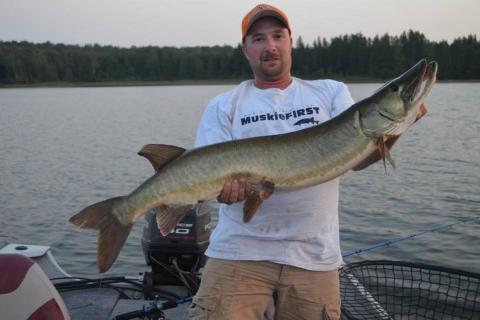
by Pros4- 1Source
Muskies are probably one of the least understood game fish for particularly good reason- they constantly seem to intentionally disprove what we are sure we as anglers think we ‘know’ about them. One of the absolute sureties in the world of muskie fishing is coming into it’s prime season; the absolute rush of topwater fishing for Esox Masquiongy.

Muskie Caught on a Nite Walker.
The generally accepted folk lore insists that when mallard ducklings hatch, that’s when the top water bite takes hold. That’s interesting lore and sort of makes sense, but it’s balderdash. Topwater baits are effective all-season long from opener to ice up in varying degrees. Once water temps hit the middle 50’s muskies get increasingly more likely to hit a topwater until surface temps reach the accepted do-not-fish zone at 80. Muskies are most active in water temps between low 60’s and middle 70’s, and that’s where
we are across much of the range in the middle of June.
The best structural elements to fish are wherever muskies roam, so the classic weed edges, sharp rock breaks, wood, current breaks, and even open water relating to baitfish will be good places to run your favorite topwater lure past a muskie.
LURE TYPES
 Zig- Zag baits came into their own in the last 15 years, led in popularity by the Suick Weagle. Ranging from around 6”long to 10” long, the lure is worked by a rhythmic combination of short bursts on the reel and a sharp twitch downward with the rod, making the bait ‘whoosh’ along in a side to side pattern. Keep the speed steady and try slow to fast letting the fish tell you what to settle on for that day. I prefer to take the figure 8 under water at about the same speed as the retrieve.
Zig- Zag baits came into their own in the last 15 years, led in popularity by the Suick Weagle. Ranging from around 6”long to 10” long, the lure is worked by a rhythmic combination of short bursts on the reel and a sharp twitch downward with the rod, making the bait ‘whoosh’ along in a side to side pattern. Keep the speed steady and try slow to fast letting the fish tell you what to settle on for that day. I prefer to take the figure 8 under water at about the same speed as the retrieve.
 Tail rotating baits are one of the most popular because they are so easy to use. Cast the bait out, and retrieve, keeping the lure on top in a very wide figure 8. Suick’s Nitewalker is one of the most effective as is Bucher Tackles Top Raider. One mistake I see with the tail rotating baits is a tendency to always move them fast. As with all topwater presentations, try slow to fast in increments and let the fish tell you what speed is best for that day.
Tail rotating baits are one of the most popular because they are so easy to use. Cast the bait out, and retrieve, keeping the lure on top in a very wide figure 8. Suick’s Nitewalker is one of the most effective as is Bucher Tackles Top Raider. One mistake I see with the tail rotating baits is a tendency to always move them fast. As with all topwater presentations, try slow to fast in increments and let the fish tell you what speed is best for that day.
Creepers : Tyrant Dictator is a great late evening and after dark lure, and are nerve wracking to work as the retrieve is very slow. The wings protruding from the lure’s side cause the bait to rock right and left as the presentation waddles along slowly. Keep the speed consistent and just under the rate where the bait destabilizes. The figure 8 should stay up on top and match the speed of the retrieve exactly.
Wobble style topwaters like the Livingston Lures: Walking Boss Magnum and Arbogast XL Jitterbug mirror the retrieve of a Creeper, but the action is totally different. I like to pitch that lure in calmer water and take a few seconds to let the rings around the lure settle out before moving the bait along. I get a lot of hits at the end of the cast using that technique. Again, keep the figure 8 wide and on top.
The Fishing Technique
None of the above-mentioned lure styles has a particular speed of retrieve to get the best action. Vary the speed, and as I have mentioned, the muskies will tell you what they want on any given day. Keep your eyes on the area 2 to 10 feet behind the lure for a following muskie.
A tell-tale swelling up of the water behind the bait will cause a double wake behind the lure. If you see that, it’s a muskie following the lure and it may be ready to strike. It’s tough to do, but make sure the speed of the lure doesn’t change and the transition to the figure 8 is smooth. Keep the figure 8 going until the fish hits or leaves. Be sure it’s gone and not just sizing up the lure a short distance away. If the muskie hits during the retrieve, keep the rod pointed at the lure and keep reeling the same speed and set the hook straight up and hard when you feel weight. You WILL set the hook too soon now and again as the strikes are so explosive it’s almost impossible not to. That’s what will keep you tying one on throughout the muskie season!
- 4545 views

